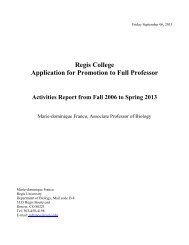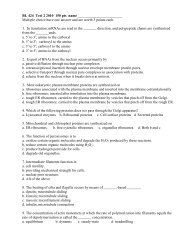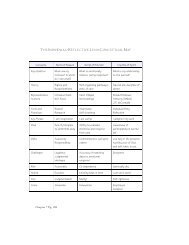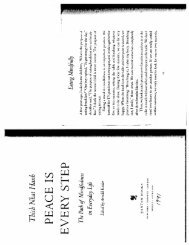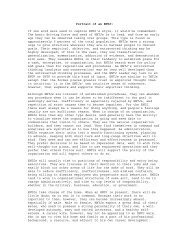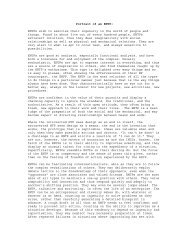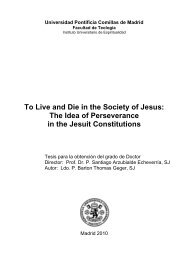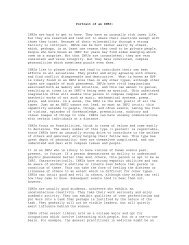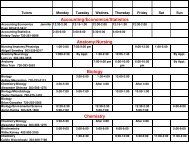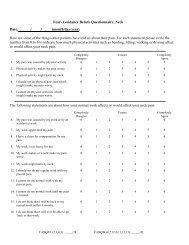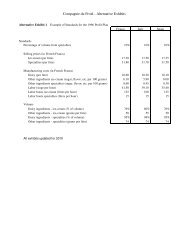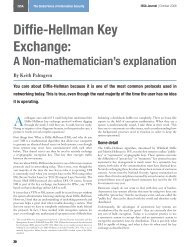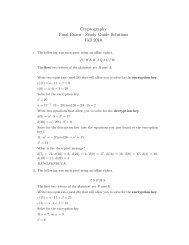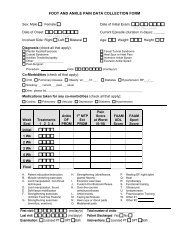Exam 2 - Regis
Exam 2 - Regis
Exam 2 - Regis
You also want an ePaper? Increase the reach of your titles
YUMPU automatically turns print PDFs into web optimized ePapers that Google loves.
Principles of Ecology<br />
BL / ENVS 402<br />
<strong>Exam</strong> II<br />
10-26-2011<br />
Name:_________________________________________<br />
There are three parts to this exam. Use your time wisely as you only have 50 minutes.<br />
Part One: Circle the BEST answer. Each question is worth 2 points<br />
1. Suppose a population of worms is variable at a genetic locus involved in foraging patterns. Individuals that<br />
are FF or Ff are rovers, and will travel widely in pursuit of food. Individuals that are ff are sitters, and will not<br />
travel as far. The frequency of the F allele is 0.75. Based on this information, rovers are what proportion of the<br />
population?<br />
a. 0.0625<br />
b. 0.125<br />
c. 0.25<br />
d. 0.375<br />
e. This question cannot be answered without further information.<br />
2. Which of the following statements about genetic drift is false?<br />
a. It affects allele frequencies the most when populations are small.<br />
b. It can cause slightly deleterious alleles to be fixed in populations.<br />
c. It tends to decrease genetic variation within populations.<br />
d. It tends to decrease genetic differences among different populations.<br />
e. All of the above are true; none is false.<br />
3. The most recent mass extinction, which wiped out the dinosaurs, occurred approximately _______ million<br />
years ago.<br />
a. 505<br />
b. 285<br />
c. 145<br />
d. 65<br />
e. 25<br />
4. As a habitat becomes fragmented, the population sizes of a species in the habitat should _______, effects of<br />
genetic drift should _______, and genetic variation within populations of this species should _______.<br />
a. increase; increase; increase<br />
b. increase; increase; decrease<br />
c. decrease; increase; decrease<br />
d. decrease; decrease; increase<br />
e. decrease; decrease; decrease<br />
5. A species of turtle grows for several years before becoming sexually mature. It mates, reproduces, and dies<br />
soon afterward. This species of turtle would best be described as<br />
a. sporophytic.<br />
b. gametophytic.<br />
c. iteroparous.<br />
d. semelparous.<br />
e. scary<br />
1
6-7. Refer to the following two graphs. Seedlings of an annual plant were split into two equal treatment groups;<br />
in one group, extra fertilizer was provided, and in the other group (the control group), no additional fertilizer<br />
was added. The numbers of seeds and the average weight of the seeds from each individual plant were<br />
monitored, and these data were plotted (each point represents an individual plant). The first graph represents the<br />
number of seeds (x-axis) and the weights of those seeds (in micrograms) (y-axis) from the control group. The<br />
second graph represents the number of seeds (x-axis) and the weights of those seeds (in micrograms) (y-axis)<br />
from the with fertilizer group.<br />
6. According to the graphs, fertilizer treatment _______ seed size and _______ seed number.<br />
a. increased; had no effect on<br />
b. increased; increased<br />
c. had no effect on; decreased<br />
d. had no effect on; increased<br />
e. decreased; increased<br />
7. Which of the following statements best describes the results of this study?<br />
a. Trade-offs between seed size and seed number existed in both the control and the fertilizer groups, and these<br />
trade-offs were of roughly equal magnitude.<br />
b. Trade-offs between seed size and seed number existed in both the control and the fertilizer groups, but these<br />
trade-offs were much larger in the fertilizer group.<br />
c. A trade-off between seed size and seed number existed in the control group but not in the fertilizer group.<br />
d. A trade-off between seed size and seed number existed in the fertilizer group but not in the control group.<br />
e. Neither the fertilizer group nor the control group showed a trade-off between seed size and seed number.<br />
8. If the population density of ocotillo in a desert is 15 per square kilometer, how many plants would be<br />
expected in an area that is 5 km by 3 km?<br />
a. 15<br />
b. 45<br />
c. 150<br />
d. 225<br />
e. 1,500<br />
2
9. An evolutionary ecologist is interested in studying the evolutionary change over the course of many years in<br />
populations of lizards that reproduce via parthenogenesis. Which type of individual would be the most<br />
appropriate focus of the study?<br />
a. Genet<br />
b. Ramet<br />
c. Opuntia<br />
d. Both a and b<br />
e. ghost<br />
10. Area-based methods often make use of sampling areas of a defined size called<br />
a. transects.<br />
b. quadrats.<br />
c. mark and recapture.<br />
d. ramets.<br />
e. cemetaries.<br />
11. Which of the following statements about population growth is true?<br />
a. Exponential population growth is always faster than geometric population growth.<br />
b. We use the term “exponential growth” when the individuals in the population reproduce in synchrony at<br />
discrete individuals.<br />
c. A population that has a of 0.88 should grow in size.<br />
d. All of the above<br />
e. None of the above<br />
12. Which of the following would not be an example of density-dependent factors regulating population size?<br />
a. The number of possible territories for robins is limited; thus when population sizes are high, a lower<br />
proportion of individuals can produce offspring.<br />
b. In conditions of overcrowding, some desert pupfish living in ponds will emigrate to other ponds if given the<br />
opportunity.<br />
c. In conditions of high density, mice are more susceptible to mortality from heat stress.<br />
d. Predation on mosquitofish is high, regardless of population size.<br />
e. All of the above are examples of density-dependent factors regulating population size.<br />
13. Which of the following statements about logistic growth is true?<br />
a. The carrying capacity is the maximum population size that can be supported by the environment indefinitely.<br />
b. At low densities, logistic growth is similar to exponential growth.<br />
c. At the carrying capacity, there is no population growth in the logistic model.<br />
d. All of the above<br />
e. None of the above<br />
14. As of 2010, the human population was just under<br />
a. 7 billion.<br />
b. 700 million.<br />
c. 3 billion.<br />
d. 17 billion.<br />
e. 30 billion, but most are zombies.<br />
3
15. Which of the following is most likely to lead to population cycles?<br />
a. Demographic stochasticity<br />
b. Genetic drift<br />
c. Delayed density dependence<br />
d. Habitat fragmentation<br />
e. Logistic growth<br />
16. Which of the following is a plausible consequence of delayed density dependence in a population that would<br />
otherwise have logistic growth?<br />
a. Increased environmental stochasticity<br />
b. Dampened oscillations<br />
c. Population cycles<br />
d. Both a and b<br />
e. Both b and c<br />
17. According to May’s model, a population that experiences delayed density dependence can exhibit logistic<br />
growth or dampened oscillations, or it can fluctuate forever in a stable limit cycle. Which two factors determine<br />
the pattern that will result?<br />
a. The population growth rate under ideal conditions and the starting population size<br />
b. The population growth rate and the time lag<br />
c. The starting population size and the time lag<br />
d. The time lag and the degree of demographic stochasticity<br />
e. The time lag and the carrying capacity<br />
18. Suppose that a population of weevils that experiences logistic growth has an initial size of 1,563 and follows<br />
the standard equation for delayed density dependence with a 5-week delay and an intrinsic growth rate of 0.15<br />
per week. If these conditions remain constant and the population is tracked for a long time, what type of<br />
population dynamics should it display? (The cutoff rτ value for dampened oscillations is 0.368, and the cutoff<br />
for a stable limit cycle is 1.57.)<br />
a. Exponential growth<br />
b. Logistic growth<br />
c. Dampened oscillations<br />
d. A stable limit cycle<br />
e. No change over time<br />
19. Suppose that two species of Darwin’s finches live on the same island and eat seeds, but one species tends to<br />
eat larger seeds than the other one does. Based on this observation, we can conclude that these species are<br />
engaged in<br />
a. resource partitioning.<br />
b. allelopathy.<br />
c. interference competition.<br />
d. competitive exclusion.<br />
e. character displacement.<br />
20. Suppose that a species of moss cannot coexist with a superior competitor unless there is periodic<br />
disturbance. This species is also a frequent disperser. Which of the following is most likely?<br />
a. The moss is engaged in character displacement.<br />
b. In a constant environment, the moss and its competitor have zero population growth isoclines that cross.<br />
c. The moss is a fugitive species.<br />
d. Both a and b<br />
e. None of the above<br />
4
21. Many species of butterflies are noxious to predators. They also have bright red coloration that indicates to<br />
the potential predators that they are unpleasant or even harmful to eat. This is an example of _______<br />
coloration.<br />
a. apomitic<br />
b. aposematic<br />
c. cryptic<br />
d. induced<br />
e. exploitative<br />
22. Different species of marine snails that are preyed on by a shore crab differ in terms of how easily the crab<br />
can crush their shells. Studies of these snails have provided evidence for<br />
a. the value of “gene silencing” in ecological studies.<br />
b. the principle of compensation.<br />
c. the presence of trade-offs between different anti-predator adaptations.<br />
d. the influence of exploitation in the distribution and abundance of food organisms.<br />
e. the headless horseman.<br />
23. Huge numbers of adult periodic cicadas emerge simultaneously from pupae at intervals of either 13 or 17<br />
years. This phenomenon is most similar to which of the following?<br />
a. Trick-or-treating<br />
b. Compensation<br />
c. Exploitation<br />
d. Allelopathy<br />
e. Masting<br />
24. The caffeine produced by coffee beans to reduce herbivory are an example of a(n)<br />
a. allelopathy<br />
b. crypsis.<br />
c. secondary compound.<br />
d. candy corn.<br />
e. compensatory agent.<br />
Part Two: Short-answer questions. Please use ONLY the space provided. Answer all five questions, which<br />
are worth six (6) points each.<br />
25. Define genetic drift and gene flow and give an example of each.<br />
5
26. Contrast resource partitioning and character displacement. Give a brief example of each.<br />
27. Draw and label the three main dispersal patterns organisms exhibit in nature. Give an example of each and<br />
describe why it would show that pattern.<br />
28. Draw the three types of life curves and give an example organism for each one. Be sure to label the axes.<br />
6
Part Three: Longer-answer questions. Answer both questions and please use only the space provided. These<br />
questions are worth eleven (11) points each.<br />
30. Suppose you are involved in a project constructing a life table for a population of a small perennial plant.<br />
Currently, there are 650 plants that are less than a year old, 347 that are between 1 and 2 years of age, 123 that<br />
are between 2 and 3 years old, and 55 that are older than 3 years. Based on previous work, the expected survival<br />
rates of plants that are less than a year old, between 1 and 2, and between 2 and 3 are 0.4, 0.6, and 0.8,<br />
respectively.<br />
Set up the correct life table using Nx, Sx, and calculate lx (5 points).<br />
Assuming that the expected survival rates remain the same, how many plants between 2 and 3 years of age<br />
should you expect to see in 12 months? Show your work (3 points)<br />
Assuming that the expected survival rates remain the same, how many plants between 2 and 3 years of age<br />
should you expect to see in 24 months? Show your work (3 points)<br />
7
31. Draw directional, stabilizing and disruptive selection and remember to label the axes (6 points). Give a one<br />
sentence biological example of these three types of selection (3 points).<br />
What is your favorite Halloween candy and why? (2 points) ________________________________________<br />
8



